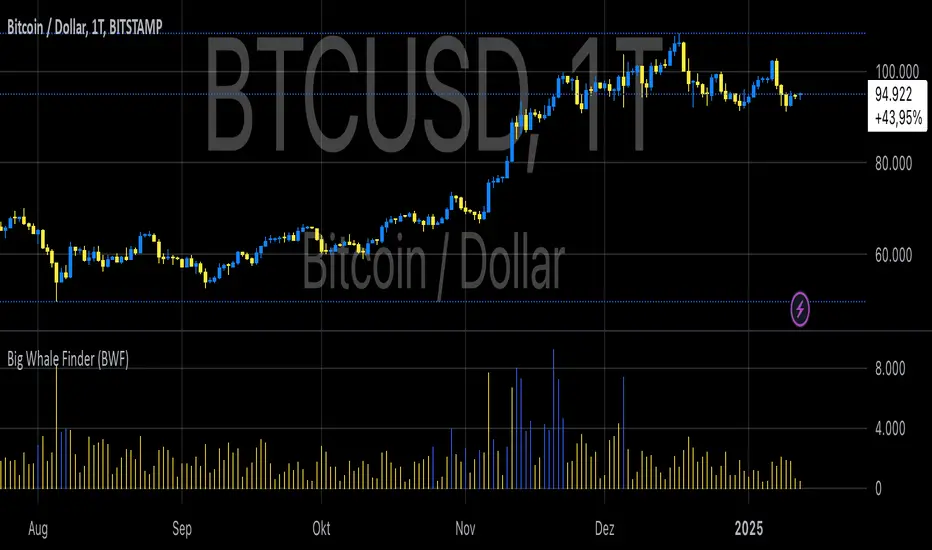Big Whale Finder (BWF)

This tool uses volume-based analysis to identify these orders, focusing on the detection of unusual volume spikes occurring in price regions where the market remains stagnant or shows minimal movement. The indicator aims to help traders identify potential areas of institutional activity, providing a strategic advantage by recognizing patterns of hidden liquidity.
Core Logic and Methodology
The BWF indicator combines two key factors to identify potential "whale" activity:
Volume Analysis: The first condition evaluates the volume relative to its average over a defined period. This is done by calculating the Simple Moving Average (SMA) of the volume and comparing current volume levels against this average. When the volume is significantly higher than the historical average, it signals the presence of a potentially large order.
Volume Threshold=Current Volume>(Average Volume×Threshold Factor)
Volume Threshold=Current Volume>(Average Volume×Threshold Factor)
According to market theory, large trades or "whale" activities often require substantial volumes to be executed. Identifying these anomalies can offer insights into the behavior of institutional players who seek to execute large transactions without disturbing the market (Lo, 2004).
Price Movement Analysis: The second condition considers the price change in relation to the volume. Specifically, if high volumes are detected but the price remains relatively stable, this suggests that large orders are being executed without significantly impacting the market price.
This phenomenon often occurs in "liquidity pools" or through algorithms designed to mask the true size of the orders. The indicator uses a price change threshold to identify this stagnation, with the condition that price movement remains below a certain percentage threshold.
Price Stagnation=(∣Close−Open∣Open)<Price Change Threshold
Price Stagnation=(Open∣Close−Open∣)<Price Change Threshold
This principle is aligned with research on market microstructure, which suggests that large institutional orders often attempt to hide their true size to avoid influencing the market (Hasbrouck, 1991).
Practical Use and Benefits
The Big Whale Finder (BWF) indicator is useful for identifying zones where large, potentially hidden orders are being executed. Traders often seek to detect these areas to better understand market dynamics and anticipate price movements. The benefits of using such an indicator include:
Increased Market Awareness: By identifying areas of high volume with minimal price movement, traders can spot potential "whale" activity that may indicate significant institutional involvement. These hidden large orders are not immediately visible in the market price, but their impact can become evident over time (Kyle, 1985).
Strategic Entry and Exit Points: Identifying areas with hidden liquidity can help traders make more informed decisions about where to enter or exit positions. A large institutional order may signal strong interest in a specific price level, and understanding this can guide strategic decisions regarding support and resistance levels.
Mitigating Price Impact: Knowing where these large orders are placed can also assist traders in avoiding price levels where they are more likely to face slippage. For instance, avoiding areas where whales are accumulating or distributing assets may help reduce the risk of unfavorable price movements.
Scientific Foundations and References
The underlying logic of this indicator draws heavily on established theories in market microstructure and behavioral finance, particularly the concept of hidden liquidity and information asymmetry. Market participants, especially institutional traders, frequently employ strategies to hide the true size of their orders to avoid influencing the market (Hasbrouck, 1991). These strategies include the use of dark pools, where large trades are executed privately and away from public view, and algorithmic trading systems that spread large orders across multiple price levels to minimize market impact (Lobel, 2012).
Research has shown that understanding these hidden liquidity dynamics can give traders a significant edge. For example, Hasbrouck (1991) emphasized that large, hidden orders may signal upcoming price trends, as they often precede significant market moves. Similarly, Lo (2004) highlighted that institutional traders' strategies to hide orders are a critical factor in market behavior, suggesting that the ability to detect these activities could enhance trading strategies.
Conclusion
The Big Wale Finder (BWF) indicator provides a powerful tool for identifying areas where large orders are being executed without significantly impacting the price. By analyzing volume and price stagnation, it helps traders uncover hidden liquidity, which is critical for anticipating potential price movements. This indicator's effectiveness lies in its ability to detect "whale" activity, offering traders insights into the actions of institutional market participants. Understanding and leveraging these insights can provide a strategic advantage in the highly competitive and information-rich landscape of financial markets.
References
Hasbrouck, J. (1991). Measuring the Information Content of Stock Trades. Journal of Finance, 46(1), 179-207.
Kyle, A. S. (1985). Continuous Auctions and Insider Trading. Econometrica, 53(6), 1315-1335.
Lo, A. W. (2004). The Adaptive Markets Hypothesis: Market Efficiency from an Evolutionary Perspective. Journal of Portfolio Management, 30(5), 15-29.
Lobel, S. (2012). Dark Pools, Price Discovery, and Market Liquidity. The Journal of Trading, 7(1), 35-42.
Script sob convite
Somente usuários aprovados pelo autor podem acessar este script. Você precisará solicitar e obter permissão para usá-lo. Normalmente, essa permissão é concedida após o pagamento. Para obter mais detalhes, siga as instruções do autor abaixo ou entre em contato diretamente com EdgeTools.
A TradingView NÃO recomenda pagar ou usar um script, a menos que você confie totalmente em seu autor e entenda como ele funciona. Você também pode encontrar alternativas gratuitas e de código aberto em nossos scripts da comunidade.
Instruções do autor
edgetools.org
Aviso legal
Script sob convite
Somente usuários aprovados pelo autor podem acessar este script. Você precisará solicitar e obter permissão para usá-lo. Normalmente, essa permissão é concedida após o pagamento. Para obter mais detalhes, siga as instruções do autor abaixo ou entre em contato diretamente com EdgeTools.
A TradingView NÃO recomenda pagar ou usar um script, a menos que você confie totalmente em seu autor e entenda como ele funciona. Você também pode encontrar alternativas gratuitas e de código aberto em nossos scripts da comunidade.
Instruções do autor
edgetools.org